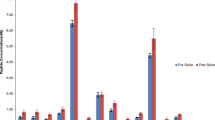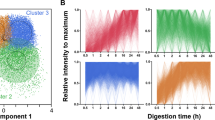Abstract
Purpose
To develop an absolute quantification method for membrane proteins, and to construct a quantitative atlas of membrane transporter proteins in the blood–brain barrier, liver and kidney of mouse.
Methods
Mouse tissues were digested with trypsin, and mixed with stable isotope labeled-peptide as a quantitative standard. The amounts of transporter proteins were simultaneously determined by liquid chromatography–tandem mass spectrometer (LC/MS/MS).
Results
The target proteins were digested in-silico, and target peptides for analysis were chosen on the basis of the selection criteria. All of the peptides selected exhibited a detection limit of 10 fmol and linearity over at least two orders of magnitude in the calibration curve for LC/MS/MS analysis. The method was applied to obtain the expression levels of 34 transporters in liver, kidney and blood–brain barrier of mouse. The quantitative values of transporter proteins showed an excellent correlation with the values obtained with existing methods using antibodies or binding molecules.
Conclusion
A sensitive and simultaneous quantification method was developed for membrane proteins. By using this method, we constructed a quantitative atlas of membrane transporter proteins at the blood–brain barrier, liver and kidney in mouse. This technology is expected to have major implications for various fields of biomedical science.







Similar content being viewed by others
Abbreviations
- ABC transporters:
-
ATP binding cassette transporters
- CV:
-
coefficient of variation
- ESI:
-
electro-spray ionization
- HSA:
-
human serum albumin
- HUGO:
-
Human Genome Organization
- LC:
-
liquid chromatography
- MRM:
-
multiple reaction monitoring
- MS/MS:
-
tandem mass spectrometry
- PBS:
-
phosphate-buffered saline
- PMSF:
-
phenylmethylsulfonyl fluoride
- Q1:
-
quadrupole 1
- Q3:
-
quadrupole 3
- SLC transporters:
-
solute carrier family of transporters
References
J. Nezu, I. Tamai, A. Oku, R. Ohashi, H. Yabuuchi, N. Hashimoto, H. Nikaido, Y. Sai, A. Koizumi, Y. Shoji, G. Takada, T. Matsuishi, M. Yoshino, H. Kato, T. Ohura, G. Tsujimoto, J. Hayakawa, M. Shimane, and A. Tsuji. Primary systemic carnitine deficiency is caused by mutations in a gene encoding sodium ion-dependent carnitine transporter. Nat. Genet. 21:91–94 (1999).
M. J. Welsh, and A. E. Smith. Molecular mechanisms of CFTR chloride channel dysfunction in cystic fibrosis. Cell 73:1251–1254 (1993).
J. Kartenbeck, U. Leuschner, R. Mayer, and D. Keppler. Absence of the canalicular isoform of the MRP gene-encoded conjugate export pump from the hepatocytes in Dubin–Johnson syndrome. Hepatology 23:1061–1066 (1996).
G. Szakacs, J. K. Paterson, J. A. Ludwig, C. Booth-Genthe, and M. M. Gottesman. Targeting multidrug resistance in cancer. Nat. Rev. Drug Discov. 5:219–234 (2006).
N. Mizuno, T. Niwa, Y. Yotsumoto, and Y. Sugiyama. Impact of drug transporter studies on drug discovery and development. Pharmacol. Rev. 55:425–461 (2003).
A. Tsuji. Impact of transporter-mediated drug absorption, distribution, elimination and drug interactions in antimicrobial chemotherapy. J. Infect. Chemother. 12:241–250 (2006).
Y. Shitara, T. Horie, and Y. Sugiyama. Transporters as a determinant of drug clearance and tissue distribution. Eur. J. Pharm. Sci. 27:425–446 (2006).
S. Ohtsuki, and T. Terasaki. Contribution of carrier-mediated transport systems to the blood–brain barrier as a supporting and protecting interface for the brain; Importance for CNS drug discovery and development. Pharm. Res. 24:1745–1758 (2007).
R. Aebersold, and M. Mann. Mass spectrometry-based proteomics. Nature 422:198–207 (2003).
S. D. Patterson, and R. H. Aebersold. Proteomics: the first decade and beyond. Nat. Genet. 33(Suppl):311–323 (2003).
B. Domon, and R. Aebersold. Mass spectrometry and protein analysis. Science 312:212–217 (2006).
H. Steen, and A. Pandey. Proteomics goes quantitative: measuring protein abundance. Trends Biotechnol. 20:361–364 (2002).
S. E. Ong, L. J. Foster, and M. Mann. Mass spectrometric-based approaches in quantitative proteomics. Methods 29:124–130 (2003).
S. P. Gygi, B. Rist, S. A. Gerber, F. Turecek, M. H. Gelb, and R. Aebersold. Quantitative analysis of complex protein mixtures using isotope-coded affinity tags. Nat. Biotechnol. 17:994–999 (1999).
J. A. Ranish, E. C. Yi, D. M. Leslie, S. O. Purvine, D. R. Goodlett, J. Eng, and R. Aebersold. The study of macromolecular complexes by quantitative proteomics. Nat. Genet. 33:349–355 (2003).
L. Anderson, and C. L. Hunter. Quantitative mass spectrometric multiple reaction monitoring assays for major plasma proteins. Mol. Cell. Proteomics 5:573–588 (2006).
G. Marko-Varga, H. Lindberg, C. G. Lofdahl, P. Jonsson, L. Hansson, M. Dahlback, E. Lindquist, L. Johansson, M. Foster, and T. E. Fehniger. Discovery of biomarker candidates within disease by protein profiling: principles and concepts. J. Proteome Res. 4:1200–1212 (2005).
D. R. Barnidge, E. A. Dratz, T. Martin, L. E. Bonilla, L. B. Moran, and A. Lindall. Absolute quantification of the G protein-coupled receptor rhodopsin by LC/MS/MS using proteolysis product peptides and synthetic peptide standards. Anal. Chem. 75:445–451 (2003).
S. A. Gerber, J. Rush, O. Stemman, M. W. Kirschner, and S. P. Gygi. Absolute quantification of proteins and phosphoproteins from cell lysates by tandem MS. Proc. Natl. Acad.Sci.USA 100:6940–6945 (2003).
H. Keshishian, T. Addona, M. Burgess, E. Kuhn, and S. A. Carr. Quantitative, multiplexed assays for low abundance proteins in plasma by targeted mass spectrometry and stable isotope dilution. Mol. Cell. Proteomics 6:2212–2229 (2007).
J. S. Andersen, C. J. Wilkinson, T. Mayor, P. Mortensen, E. A. Nigg, and M. Mann. Proteomic characterization of the human centrosome by protein correlation profiling. Nature 426:570–574 (2003).
S. Hori, S. Ohtsuki, M. Tachikawa, N. Kimura, T. Kondo, M. Watanabe, E. Nakashima, and T. Terasaki. Functional expression of rat ABCG2 on the luminal side of brain capillaries and its enhancement by astrocyte-derived soluble factor(s). J. Neurochem. 90:526–536 (2004).
R. J. Boado, and M. M. Pardridge. A one-step procedure for isolation of poly(A) mRNA from isolated brain capillaries and endothelial cells in culture. J. Neurochem. 57:2136–2139 (1991).
W. M. Pardridge, R. J. Boado, and C. R. Farrell. Brain-type glucose transporter (GLUT-1) is selectively localized to the blood–brain barrier. Studies with quantitative western blotting and in situ hybridization. J. Biol. Chem. 265:18035–18040 (1990).
K. G. Mawuenyega, H. Kaji, Y. Yamuchi, T. Shinkawa, H. Saito, M. Taoka, N. Takahashi, and T. Isobe. Large-scale identification of Caenorhabditis elegans proteins by multidimensional liquid chromatography–tandem mass spectrometry. J. Proteome Res. 2:23–35 (2003).
P. Chen, X. Li, Y. Sun, Z. Liu, R. Cao, Q. He, M. Wang, J. Xiong, J. Xie, X. Wang, and S. Liang. Proteomic analysis of rat hippocampal plasma membrane: characterization of potential neuronal-specific plasma membrane proteins. J. Neurochem. 98:1126–1140 (2006).
K. Nagano, M. Taoka, Y. Yamauchi, C. Itagaki, T. Shinkawa, K. Nunomura, N. Okamura, N. Takahashi, T. Izumi, and T. Isobe. Large-scale identification of proteins expressed in mouse embryonic stem cells. Proteomics 5:1346–1361 (2005).
A. V. Pshezhetsky, M. Fedjaev, L. Ashmarina, A. Mazur, L. Budman, D. Sinnett, D. Labuda, J. F. Beaulieu, D. Menard, I. Nifant’ev, and E. Levy. Subcellular proteomics of cell differentiation: quantitative analysis of the plasma membrane proteome of Caco-2 cells. Proteomics 7:2201–2215 (2007).
E. Kuhn, J. Wu, J. Karl, H. Liao, W. Zolg, and B. Guild. Quantification of C-reactive protein in the serum of patients with rheumatoid arthritis using multiple reaction monitoring mass spectrometry and 13C-labeled peptide standards. Proteomics 4:1175–1186 (2004).
S. L. Wu, H. Amato, R. Biringer, G. Choudhary, P. Shieh, and W. S. Hancock. Targeted proteomics of low-level proteins in human plasma by LC/MSn: using human growth hormone as a model system. J. Proteome Res. 1:459–465 (2002).
D. R. Barnidge, M. K. Goodmanson, G. G. Klee, and D. C. Muddiman. Absolute quantification of the model biomarker prostate-specific antigen in serum by LC-Ms/MS using protein cleavage and isotope dilution mass spectrometry. J. Proteome Res. 3:644–652 (2004).
D. D. Sabatini, and G. Blobel. Controlled proteolysis of nascent polypeptides in rat liver cell fractions. II. Location of the polypeptides in rough microsomes. J. Cell. Biol. 45:146–157 (1970).
P. Mallick, M. Schirle, S. S. Chen, M. R. Flory, H. Lee, D. Martin, J. Ranish, B. Raught, R. Schmitt, T. Werner, B. Kuster, and R. Aebersold. Computational prediction of proteotypic peptides for quantitative proteomics. Nat. Biotechnol. 25:125–131 (2007).
S. Ohtsuki. New aspects of the blood–brain barrier transporters; its physiological roles in the central nervous system. Biol. Pharm. Bull. 27:1489–1496 (2004).
S. Conrad, A. Viertelhaus, A. Orzechowski, J. Hoogstraate, K. Gjellan, D. Schrenk, and H. Kauffmann. Sequencing and tissue distribution of the canine MRP2 gene compared with MRP1 and MDR1. Toxicology 156:81–91 (2001).
A. H. Schinkel, U. Mayer, E. Wagenaar, C. A. A. Mol, L. Deemter, J. M. Zijlmans, W. E. Fibbe, and P. Borst. Normal viability and altered pharmacokinetics in mice lacking mdr1-type (drug-transporting) P-glycoproteins. Proc. Natl. Acad. Sci. USA 94:4028–4033 (1997).
Y. Huang. Pharmacogenetics/genomics of membrane transporters in cancer chemotherapy. Cancer Metastasis Rev. 26:183–201 (2007).
J. Konig, A. Seithel, U. Gradhand, and M. F. Fromm. Pharmacogenomics of human OATP transporters. Naunyn Schmiedebergs Arch. Pharmacol. 372:432–443 (2006).
C. Hilgendorf, G. Ahlin, A. Seithel, P. Artursson, A. L. Ungell, and J. E. Karlsson. Expression of thirty-six drug transporter genes in human intestine, liver, kidney, and organotypic cell lines. Drug Metab. Dispos. 35:1333–1340 (2007).
T. Terasaki, and S. Ohtsuki. Brain-to-blood transporters for endogenous substrates and xenobiotics at the blood–brain barrier: an overview of biology and methodology. NeuroRx 2:63–72 (2005).
Acknowledgements
We would like to thank Ms N. Funayama for secretarial assistance. This study was supported in part by a Grant-in-Aid for Young Scientist (B) and Scientific Research on Priority Areas (17081002) from the Ministry of Education, Culture, Sports, Science and Technology of Japan, and Grant-in-Aid for Scientific Research (S), Scientific Research (B) and a 21st Century Center of Excellence (COE) Program grant from the Japan Society for the Promotion of Science. This study was also supported in part by the Industrial Technology Research Grant Program from New Energy and the Industrial Technology Development Organization (NEDO) of Japan.
Author information
Authors and Affiliations
Corresponding author
Rights and permissions
About this article
Cite this article
Kamiie, J., Ohtsuki, S., Iwase, R. et al. Quantitative Atlas of Membrane Transporter Proteins: Development and Application of a Highly Sensitive Simultaneous LC/MS/MS Method Combined with Novel In-silico Peptide Selection Criteria. Pharm Res 25, 1469–1483 (2008). https://doi.org/10.1007/s11095-008-9532-4
Received:
Accepted:
Published:
Issue Date:
DOI: https://doi.org/10.1007/s11095-008-9532-4




